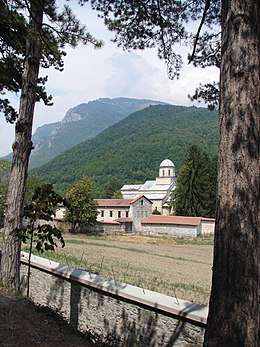Medieval Monuments in Kosovo
The Medieval Monuments in Kosovo (Serbian: Средњовековни споменици на Косову, romanized: Srednjovekovni spomenici na Kosovu, Albanian: Monumentet Mesjetare në Kosovë) are a World Heritage Site consisting of four Serbian Orthodox Christian churches and monasteries which represent the fusion of the eastern Orthodox Byzantine and the western Romanesque ecclesiastical architecture to form the Palaiologian Renaissance style. The construction was founded by members of Nemanjić dynasty, the most important dynasty of Serbia in the Middle Ages. The sites are located in the modern-day Kosovo.[a]
| UNESCO World Heritage Site | |
|---|---|
 Clockwise from top left: Church of Patriarchal Monastery of Peć, Our Lady of Ljeviš, Church of Visoki Dečani, a window at Visoki Dečani, Church of Gračanica, fresco of Christ at Our Lady of Ljeviš | |
| Location | Autonomous province of Kosovo, Serbia |
| Includes |
|
| Criteria | Cultural: (ii), (iii), (iv) |
| Reference | 724bis |
| Inscription | 2004 (28th session) |
| Extensions | 2006 |
| Endangered | 2006–... |
| Area | 2.8802 ha (7.117 acres) |
| Buffer zone | 115.3879 ha (285.130 acres) |
| Coordinates | 42°39′40″N 20°15′56″E |
 Location of Medieval Monuments in Kosovo in Kosovo  Medieval Monuments in Kosovo (Serbia) | |

In 2004, UNESCO recognized the Dečani Monastery for its outstanding universal value. Two years later, the site of patrimony was extended as a serial nomination, to include three other religious monuments: Patriarchate of Peć Monastery, Our Lady of Ljeviš and Gračanica Monastery.
In 2006 the property was inscribed on the list of World Heritage in Danger due to difficulties in its management and conservation stemming from the region's political instability.[1]
UNESCO controversy
There is an ongoing controversy over Kosovo's bid to join the UNESCO, which would result in the sites being listed as part of Kosovo and not Serbia.[2] These monuments have come under attack, especially during the ethnic violence in 2004, during Kosovo's UNMIK rule, when the Our Lady of Ljeviš was heavily damaged.[3][4][5][6] In October 2015 Kosovo was recommended for membership by the UNESCO Executive Board. The bid for membership was voted at the UNESCO General Conference in November 2015.[7]
UNESCO has not accepted Kosovo as a member, the proposal failed to gain a two-thirds majority at the organization's General Conference in Paris on November 9, 2015.[8][9] One of primary reasons for this rejection of Albanian request[10][11][12] is 2004 unrest in Kosovo, when 35 Orthodox churches were desecrated, damaged or destroyed,[13][14] including Our Lady of Ljeviš which is a World Heritage Site.[15][16] The church is subject to constant looting - even of its construction material, specifically valuable lead has repeatedly been stolen from the roof.[17]
Gallery
.jpg)
 Patriarchal Monastery of Peć
Patriarchal Monastery of Peć Gračanica
Gračanica
See also
- Kosovo: A Moment in Civilization
- Destruction of Albanian heritage in Kosovo
- Destroyed Serbian heritage in Kosovo
Notes
| a. | ^ Kosovo is the subject of a territorial dispute between the Republic of Kosovo and the Republic of Serbia. The Republic of Kosovo unilaterally declared independence on 17 February 2008, but Serbia continues to claim it as part of its own sovereign territory. The two governments began to normalise relations in 2013, as part of the 2013 Brussels Agreement. Kosovo is currently recognized as an independent state by 97 out of the 193 United Nations member states. In total, 112 UN member states recognized Kosovo at some point, of which 15 later withdrew their recognition. |
References
- World Heritage Committee puts Medieval Monuments in Kosovo on Danger List and extends site in Andorra, ending this year’s inscriptions, UNESCO World Heritage Centre, July 13, 2006. Accessed April 4, 2008.
- http://www.rferl.org/content/kosovo-serbia-fights-unesco-membership/27320037.html Missing or empty
|title=(help) - "Safeguarding of Cultural Heritage in Kosovo". UNESCO. 2005.
- "Protection and Preservation of Cultural Heritage in Kosovo" (PDF). UNESCO. 2005. pp. 7, 8.
- "The Violence: Ethnic Albanian Attacks on Serbs and Roma". Human Rights Watch. July 2004.
- "Reconstruction Implementation Commission for Serbian Orthodox Religious Sites in Kosovo". Council of Europe. 2005.
- "Kosovo Moves Closer To UNESCO Membership".
- http://tass.ru/en/world/834899
- https://www.nytimes.com/aponline/2015/11/09/world/europe/ap-unesco-kosovo.html
- http://www.b92.net/eng/news/politics.php?yyyy=2015&mm=09&dd=14&nav_id=95418
- "Archived copy". Archived from the original on 2017-05-29. Retrieved 2015-11-09.CS1 maint: archived copy as title (link)
- http://www.businessinsider.com/ap-kosovo-hopes-to-join-unesco-vows-to-protect-serb-heritage-2015-11
- RIC, RECONSTRUCTION IMPLEMENTATION COMMISSION FOR ORTHODOX RELIGIOUS SITES IN KOSOVO ACTIVITY REPORT
- "Six years since March violence in Kosovo". B92. 17 March 2010. Retrieved 7 September 2015.
- For details and photos see here: http://www.spc.rs/eng/prizren_our_lady_ljevis_xiv_century_burnt_inside_photo_2232004
- and here: "Around 900 houses and 35 churches and monasteries of the Serbian Orthodox Church were set on fire, including mediaeval holy sites such as the Church of Our Lady of Ljevis in Prizren which dates back to the 14th century." http://www.pravoslavie.ru/english/52282.htm
- See the link: "Archived copy". Archived from the original on 2015-12-23. Retrieved 2015-11-09.CS1 maint: archived copy as title (link)
External links
![]()
- Medieval Monuments in Kosovo at the official UNESCO site
- Mediaeval monuments in Kosovo, National Tourism Organisation of Serbia
- Medieval Monuments in Kosovo, 'Learn the World'